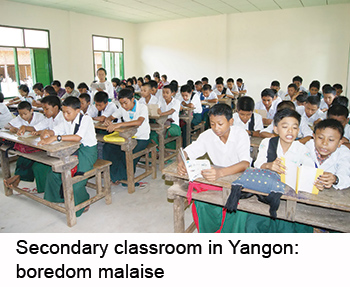
Only one in ten students remain in school that long and passes the final exams. Although the vast majority of children in Myanmar enroll in primary school, half of them drop out by the second year of secondary school. Some do so because their families need the income they could earn by working. But most cite boredom, not poverty, as the main reason.
Myanmar’s schools weren’t always so bad. A centuries-old tradition of monastic education gave Myanmar one of the highest literacy rates in South-east Asia at the time of independence, in 1948. The University of Rangoon (as Yangon was then known) was one of the most respected in the region. Under British rule, knowledge of English spread widely.
All this changed after the army seized power in 1962. In 2007-10 the government spent less than 1 percent of GDP on education. The military regime saw textbooks as a tool of indoctrination rather than instruction. In class, children were taught never to question authority. Fear, says Ma Thida, a Burmese writer, is rooted in Burmese minds from a very young age. She believes the atrocious education system has led to a society that is “intellectually blind”.
Aung San Suu Kyi, the country’s de facto leader, whose National League for Democracy (NLD) took over from an army-backed government last year, says things will change. Education is one of the NLD’s priorities. A glossy booklet produced by the ministry of education promises to give Burmese children “21st-century skills”. The National Education Strategic Plan aims to develop vocational training and inject a dose of critical thinking into classrooms.
But the process is chaotic and disjointed. At least nine foreign organisations are involved in fixing different parts of the system. Only kindergarten and first grade are using the new curriculum, with four conflicting schedules for when it will be introduced in other years. The final exams — the only thing students and parents really care about — are still untouched. “As it is, the curriculum seems like a bridge to nowhere,” says Rosalie Metro of the University of Missouri-Columbia.
The National Network for Education Reform, an organisation of students, teachers and civil-society organisations, says the ministry of education doesn’t listen to them. Thein Lwin, who is a member of the network, used to advise Suu Kyi, but was sacked after helping students air their grievances during the passage of the education law. The new government may want more critical thinking in the classroom, but it doesn’t seem to welcome it in public life.